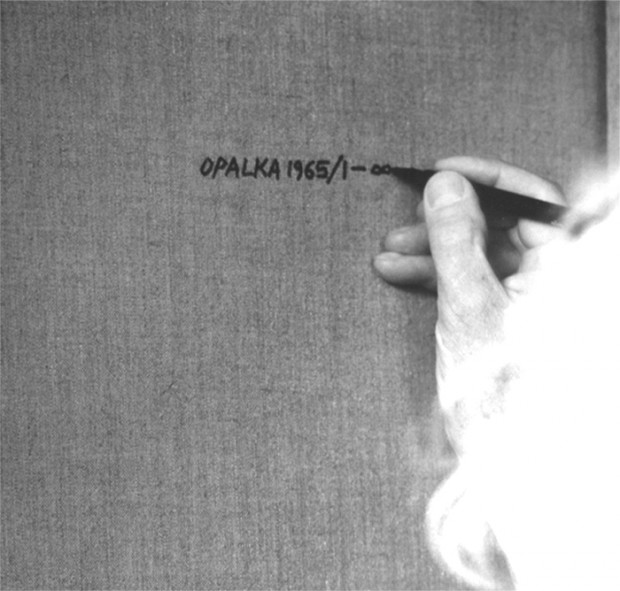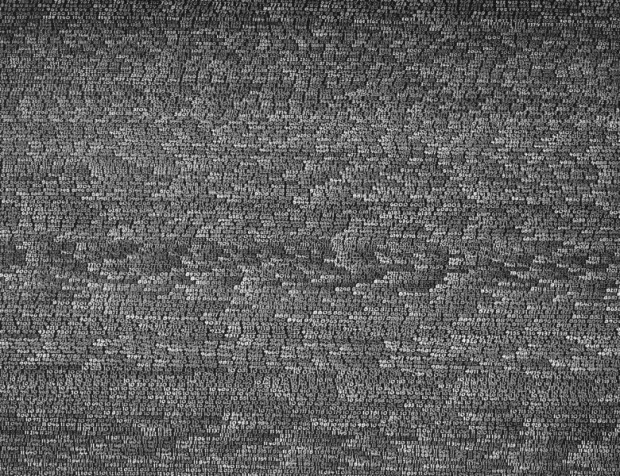An iconographic and text archive related to communication, technology and art.
☛ O.pl magazine (portal of Polish culture): “Detail 1-35327” (detail) by Roman Opałka from the 1965 / 1 – ∞ series, synthetic polymer paint on canvas, 196 cm x 135 cm, 1965.
Obituary and explanation from The Telegraph.co.uk (August 26, 2011):
Roman Opalka, who died on August 6 [2011] aged 79, was a conceptual artist known for a series of paintings consisting of a sequence of numbers to represent the passage of time; as his ultimate goal was infinity, it was a project he never completed.
Opalka began what he described as “a philosophical and spiritual image of the progression of time and of life and death’’ in 1965, when he took up a fine brush and painted a tiny white number “1” in acrylic paint on the upper-left corner of a black canvas. He continued painting neat rows of tiny numbers from one side of the canvas to the other. When he reached the lower-right corner, he was up to 35,327. Then he took up another canvas — or “detail”, as he called it — and began again, from the number 35,328, and so on. Typically he would paint around 400 figures a day.
In the early 1970s, after completing each canvas, Opalka began adding tiny amounts of white paint to the background colour and recording his voice reading the sequence of numbers. He also began taking black-and-white photographs of his own face — always with the same deadpan expression, always wearing the same shirt.
He called the paintings (of which there are 233 in total) Opalka 1965/1-∞ and aimed to carry on until the day he died. While his goal was infinity, he once said that he would be happy to reach 7,777,777, a number with “a profound, philosophical and religious meaning’’. In fact, he is thought to have stopped short of 6,000,000, though perhaps it was difficult to tell, as by the end of his Sisyphean journey he was painting white numerals on a white background — a colour he called “blanc merité” (“well-earned white’’).
The above photo shows only a detail of the very first painting of the 1965 / 1 – ∞ series (thus numbered “1-35327”. This painting resides in the collection of the Art Museum in Łódź. As for the last number, the home page for Roman Opałka official website states:
On August 6th 2011, Roman Opalka completed his work: ‘the finite defined by the nonfinite’
Under those words is an image of the handwritten (not painted) number “5607249”. The name of the image file is “lastNumber.jpg“.
From the same official website, here is the artist statement:
The fundamental basis of my work, to which I have dedicated my life, manifests itself in a process of recording a progression that both documents time and also defines it. It began on a single date in 1965, the one on which I undertook my first “Detail”.
Each “Detail” is a part of a greater idea conceived on that date. My work records the progression to infinity, through the first and the last number painted on the canvas.
I inscribe the progression of numbers beginning with one, proceeding to infinity, on canvases of the same size, 77.17 x 53.15 in (196 x 135 cm), in white by hand with a paintbrush. Since 1972 I have been making each canvas’ background about 1% whiter each time. Thus the moment will arrive when I will paint white on white. Since 2008, I have painted in white on a white background, which I call “blanc mérité” (white well earned).
After each work session in my studio, I take a photograph of my face in front of the “Detail” that I have been working on. Each “Detail” is accompanied by a tape recording of my voice saying the numbers out loud as I write them

More resources online about Roman Opałka:
- The Economist: “Roman Opalka, painter of infinity, died on August 6th, aged 79”, August 20, 2011. Excerpt:
SLOWLY, though his heart was pounding like a runner’s, Roman Opalka approached the canvas. He had painted it completely black. The date, though he set no store by dates, was 1965. Clenched in his left hand was a pot of white acrylic paint; held tightly in his right was a No. 0 brush, the smallest standard size. He dipped the fine tip into the paint and then, very gently, as if in slow motion, raised his arm. His hand was trembling. Carefully he painted the figure 1 at the top left-hand corner of the canvas. At the same time he whispered, in his native Polish, jeden, one. The moment was so charged with emotion that he thought he might collapse. Instead, he had begun.
- The New York Times: “Roman Opalka, an Artist of Numbers, Is Dead at 79” by William Grimes, August 9, 2011. Excerpt:
Though his artistic quest might have seemed bloodless and abstract, Mr. Opalka described it, passionately, as a grand metaphor for human existence. “Time as we live it and as we create it embodies our progressive disappearance,” he wrote in an essay in 1987. “We are at the same time alive and in the face of death — that is the mystery of all living beings.”
- Praz-Delavallade Gallery (Paris) held an exhibition about Roman Opałka back in 2004. One can browse through some images of Opałka’s paintings and photographs.
- The National Gallery of Australia holds one of Opałka’s “Detail” painting (numbered 868149 through 893746).

